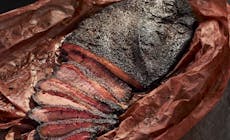Save on select Weber Works™ Accessories* Shop Now.
Texas-Style Smoked Brisket
Dustin Green
Fuel Type:
- Serves 12 to 16
People
Serves 12 to 16
Prep Time
30 mins
Marinating Time
12 to 24 h
Grilling Time
12 h
Resting Time
6 h

Ingredients
Instructions
the Ingredients

Special Equipment
- Weber Butcher Paper
Instructions
Even among Texans, there is plenty of debate about the best way to smoke a brisket. However, the one thing everyone agrees on is that a good brisket rub should have plenty of ground black pepper.
- Mix the mustard and pickle juice together in a small bowl and set aside.
- Mix the black pepper and salt together in a separate bowl and set aside.
- To trim the brisket, remove it from any packaging and pat it dry with paper towels.
- With the fat-side of brisket facing down, use a sharp knife to remove any excess fat from the bottom of the brisket, also removing the hard, thick fat towards the point-end of the brisket.
- Turn the brisket over and trim off the excess fat (also called the fat cap), leaving a ¼" thick layer, trying to avoid exposing any meat. Then, trim the front of the flat-end, rounding off the corners.
- Turn the brisket over again and spread a thin layer of the mustard mixture over the brisket, then sprinkle a generous amount of the rub on top, patting the rub into the meat.
- Turn the brisket over, and repeat the seasoning process with the fat cap. For best results, place the brisket in a large aluminum foil pan and refrigerate, covered with plastic wrap, for 12–24 hours.
- Set the grill to 250°F. When the grill has come to temperature, brush the grates clean.Prepare the grill for indirect, low & slow cooking, 225°–275°F. Remove the grates from the indirect side of the grill and place a foil drip pan on the flavorizer bars, then fill with 4 cups of water. Replace the cooking grates over the drip pan.Use the snake method to prepare the kettle grill for indirect, low & slow cooking.
- Place the wood chips in a smoker box over the lit burners. Preheat the grill until smoke appears and brush the grates clean.Place an aluminum foil pan in the center of the charcoal grate and fill halfway with water. Line the perimeter of the kettle with 2 rows of briquettes that circle ¾ of the way around, placing a 2nd row of 2 briquettes on top of the first row. Be sure that the briquettes are lined up vertically, and that all the briquettes are touching.Place the wood chunks on top of the charcoal, toward the beginning of the snake. Light the snake with 8–10 lit briquettes and adjust the dampers to achieve a temperature of 225°–275°F
- Insert the probe into the thickest part of the brisket, making sure the probe isn’t in the fat separating the point from the flat.
- Place the brisket, fat-side up in the grill. Cook until the bark has set and the internal temperature is around 165°F, 6–8 hours.Place the brisket, fat-side up, above the water pan. Cook until the bark has set and the internal temperature is around 165°F, 6–8 hours.Place the brisket, fat-side up above the water pan. Cook until the bark has set and the internal temperature is around 165°F, 6–8 hours, rotating the cooking grate as necessary to keep the bottom of the brisket from burning.
- Remove the brisket from the grill and wrap in butcher paper, then wrap in a layer of heavy-duty aluminum foil, being sure not to make the foil airtight.
- Cook the wrapped brisket until a probe slides through the meat with little resistance and the internal temperature is 201°–207°F, 2–4 hours more.
- Remove the brisket from the grill, wrap in a towel and place in a cooler to rest for 6 hours, until the internal temperature is 140°–150°F.
- To serve, slice the flat of the brisket against the grain, stopping when you’ve reached the point. Rotate the brisket ¼ turn to slice the point against the grain.
